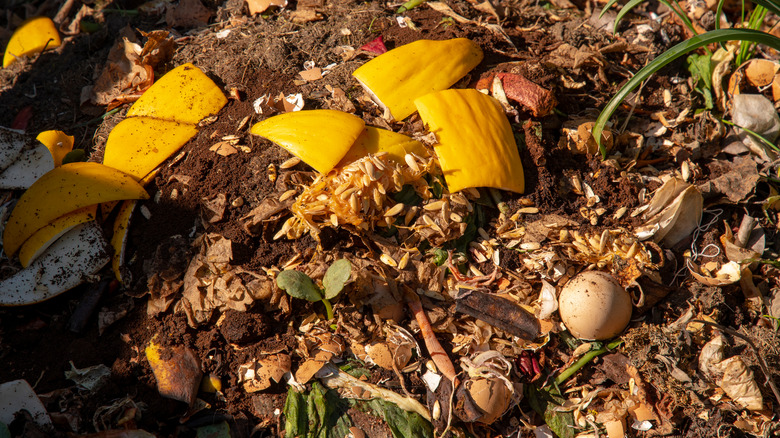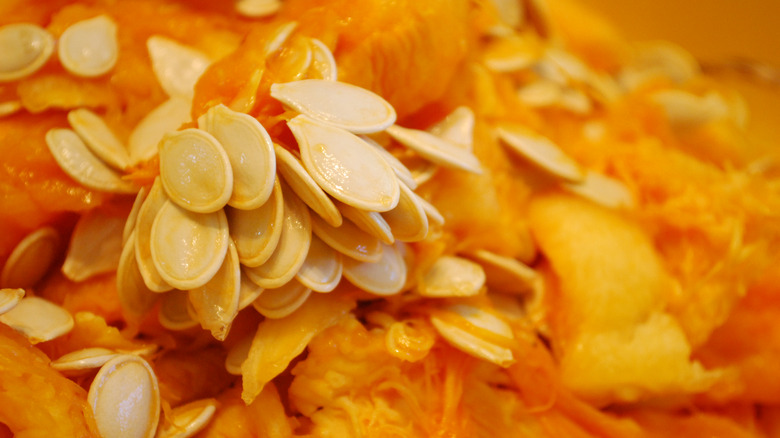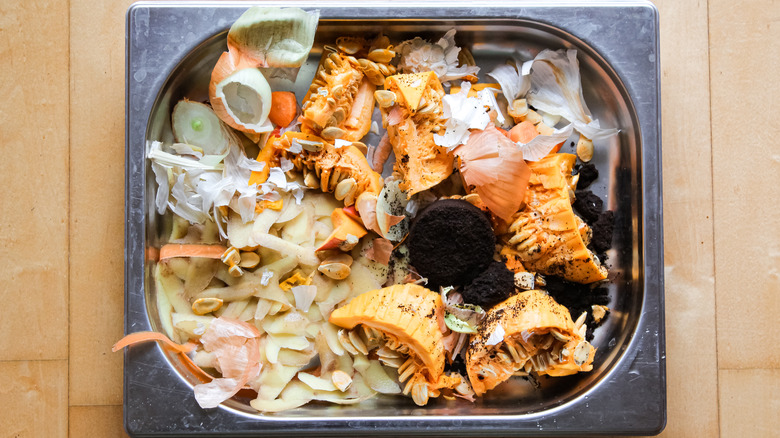Why You Should Add Pumpkin Seeds To Your Compost Pile
Carving your pumpkins this fall is a tradition few would consider missing. But the cool season enthusiasm for all things pumpkin results in well over a billion pounds of gourds ending up in landfills across the country. The obvious solution is to compost them instead of throwing them in the trash. But what do you do with the seeds? It turns out that banning pumpkin seeds from compost piles is somewhat of a myth — depending on how you compost. So why should you add them?
Well, they are packed full of nutrients that boost the effectiveness of your compost. Pumpkins and their seeds contain vitamin A, fiber, and beta carotene and, like almost all other plants, are a source of nitrogen once broken down by decomposition. Nitrogen, potassium, and phosphorous are core components of plant fertilizers, so the seeds will add a boost of plant-happy nutrients to your pile. Pumpkins are also moist. A compost pile requires a careful balance of wet and dry materials to maintain adequate levels of microbial activity, which breaks down organic matter into usable soil.
Hot composting prevents seeds from sprouting
Plants in the squash family, which includes pumpkins, are generally considered easy to grow. This is something that many gardeners who've had surprise pumpkin vines popping up in their compost pile can attest to. That's right; if you don't compost your pumpkin seeds properly, they'll likely sprout right where they lay! If you don't want to start an accidental pumpkin patch, you must "cook" the seeds in a hot compost that reaches an internal temperature of 150 degrees Fahrenheit for at least three days.
First, remove any glitter, melted wax, ribbons, paint, or other non-organic decorations from the outside of your pumpkins. You don't want any plastic mixed in with your seeds! Create a pile of organic material that measures at least 5 square feet. Add your pumpkin seeds (and flesh and skin, if you wish, with larger pieces cut to around 2 or 3 inches). Balance the carbon in the pumpkin seeds with a lot of nitrogen-producing matter, like damp grass clippings or even fish frames. Plus, turning your compost pile is a must to ensure proper aeration.
What to do if you can't hot compost
If you don't have the patience for hot composting, you can still add pumpkin seeds to a "cold" compost pile. Cold composting consists of piling up organic waste, like kitchen scraps, lawn clippings, and fallen leaves. Insects and microorganisms in the soil slowly break down this waste into nutrient-filled soil with little to no monitoring from the gardener. It's a truly set-and-forget method!
If you want to take advantage of their aforementioned nutritional benefits and add pumpkin seeds to a cold compost, you need to take a few steps to ensure they don't grow into gourd vines that take over your pile. Boil the seeds before adding them to your cold compost. The toasty temperature of boiling water kills the embryo inside the kernel, halting germination. Alternatively, clean the flesh from the seeds and dry them in your oven using a slow, low-temperature bake. Once dry, add them to your compost along with other dry materials. You can also "weed" your compost pile — in other words, watch your compost pile for sprouting pumpkin seeds and pull them out while still seedlings.


